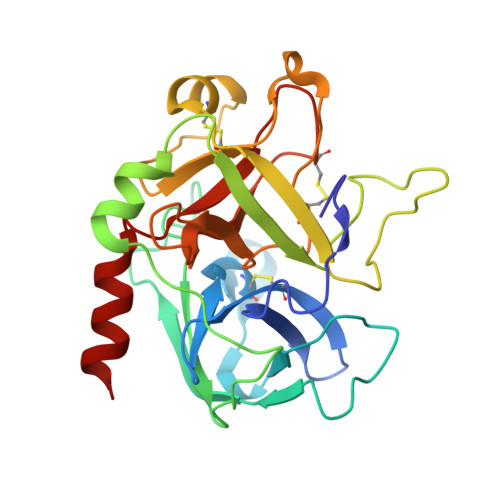Gpibalpha Interacts Exclusively with Exosite II of Thrombin
Lechtenberg, B.C., Freund, S.M.V., Huntington, J.A.(2014) J Mol Biology 426: 881
- PubMed: 24316004
- DOI: https://doi.org/10.1016/j.jmb.2013.11.027
- Primary Citation of Related Structures:
4CH2, 4CH8 - PubMed Abstract:
Activation of platelets by the serine protease thrombin is a critical event in haemostasis. This process involves the binding of thrombin to glycoprotein Ib¦Į (GpIb¦Į) and cleavage of protease-activated receptors (PARs). The N-terminal extracellular domain of GpIb¦Į contains an acidic peptide stretch that has been identified as the main thrombin binding site, and both anion binding exosites of thrombin have been implicated in GpIb¦Į binding, but it remains unclear how they are involved. This issue is of critical importance for the mechanism of platelet activation by thrombin. If both exosites bind to GpIb¦Į, thrombin could potentially act as a platelet adhesion molecule or receptor dimerisation trigger. Alternatively, if only a single site is involved, GpIb¦Į may serve as a cofactor for PAR-1 activation by thrombin. To determine the involvement of thrombin's two exosites in GpIb¦Į binding, we employed the complementary methods of mutational analysis, binding studies, X-ray crystallography and NMR spectroscopy. Our results indicate that the peptide corresponding to the C-terminal portion of GpIb¦Į and the entire extracellular domain bind exclusively to thrombin's exosite II. The interaction of thrombin with GpIb¦Į thus serves to recruit thrombin activity to the platelet surface while leaving exosite I free for PAR-1 recognition.
Organizational Affiliation:
Department of Haematology, Cambridge Institute for Medical Research, University of Cambridge, Wellcome Trust/MRC Building, Hills Road, Cambridge CB2 0XY, United Kingdom.






















